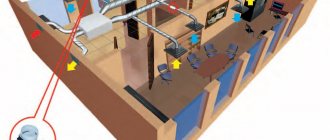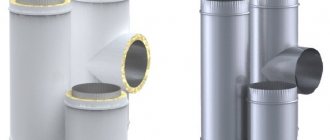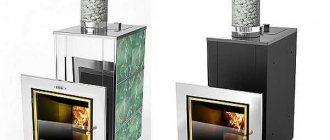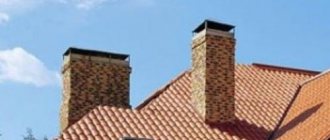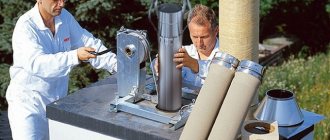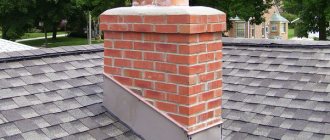- Cast iron
The functioning of stoves indoors or in a sauna directly depends on the installed chimney. From it, oxygen-saturated air is directed into the firebox, which is required to maintain stable combustion. The resulting smoke, soot and processed gases are removed from the room through a pipe. To regulate the combustion process and prevent heat loss, they resort to installing furnace rotary dampers for chimneys made of stainless steel and other materials.
Functions, purpose and characteristics
This special partition is a mandatory part of the channels responsible for the smoke exhaust. Its presence guarantees the safe operation of the installed stove or fireplace, as it ensures the fire resistance of the entire heating system in the room. It completely duplicates the cross-section and area of the chimney lumen. When closing, seasonality should be taken into account, since in winter it is allowed to retract the damper half its length, and open it completely in summer. Solid overlap is prohibited.
Its maneuverability makes it possible to increase or decrease the pipe cross-section, which increases or decreases the air supply after the stove is fired, respectively.
Externally, this damper looks like a small metal plate, which is adjusted using a handle located outside. This provides manual adjustment, allowing the owner to independently change the position of the partition. Regardless of the type of structure, it is mounted by placing it inside a pipe and then securing it with a clamp.
The chimney damper is responsible for several functions:
- Increases traction in adverse weather.
- Injects air that increases combustion power.
- Reduces draft in windy weather.
- Prevents heat leakage when heating the heater.
- Reduces combustion intensity, allowing you to save on fuel.
How is traction adjusted?
Adjustment is the most important aspect of operating furnace equipment. With proper control of this process, you can achieve the highest efficiency from the device, as well as save the health of the residents of the house. Even if the partition is completely blocked, there is still a gap for the movement of exhaust gases. It must be closed exclusively in the final part of the firebox (after the wood has finished burning and an ash layer has formed on it). According to fire safety requirements, the damper must have a small hole through which weak gas exchange occurs.
Considering the importance of this element, it is necessary to choose trusted manufacturers. Such as the manufacturing company Ferrum.
Types of valves for pipes
They come in two types: retractable and rotary. Based on the name, it becomes clear that their difference is the principle of operation. The first operates due to perpendicular movements of the partition relative to the chimney lumen. To increase traction, it moves back and completely leaves its boundaries, and to reduce the flow it will need to be pushed back. The second involves a rotating mechanism located inside the pipe.
Retractable
This type is considered a comfortable and effective method of traction control. Its main difference is its long service life, which is achieved due to the absence of temporary wear in the axial fastening areas. Due to this, it is possible to maintain the high quality and safety of the gate, even under unfavorable environmental conditions. But it is often possible to find ready-made additional structures for a metal skylight with an oval or rectangular hole.
Retractable type is also divided into:
- Simple - has the form of a rectangular groove mounted inside the passage. It contains a special plate responsible for opening the chimney.
- The unit is a ready-made unit, created as a retractable plate into which a pipe section is built. Its advantage is the ease of insertion, which significantly speeds up installation.
Rotary damper for chimney
The principle of its operation is based on the rotation of the partition around its axis. When turned counterclockwise at a right angle, the damper closes the air flow. If the turn is carried out in the opposite direction, then no obstacles are created in the path of the air. To regulate this process, you need to operate a special handle.
Difference in models depending on material
Various materials can be used for the production of chimney valves: cast iron and steel. They have shown the most reliable performance characteristics, allowing them to be resistant to high temperatures.
Cast iron
Quite durable and long service life. Disadvantages:
- heavy weight, which increases the load on the structure;
- difficulties encountered during installation;
- in case of use in wet conditions - poor corrosion resistance.
Used in chimneys made of brick base.
Stainless steel
A device made from this material belongs to the universal category. Excellent for installation in stoves, fireplaces and chimneys made of brick (pre-lined with a stainless steel pipe) or metal.
Steel structures have a simpler appearance, but are not much inferior to cast iron in properties. Their significant advantage is their light weight, which reduces the load. In addition, they are mounted on all kinds of chimneys (rectangular and oval, heavy, made of brick, etc.). When choosing a damper for a furnace, you will need to take into account not only the operational properties, but also the overall interior of the room.
Which material is stronger
In addition to structural differences, gate valves differ based on the material used at the manufacturing stage. The only available solution is stainless steel. This is due to the fact that it does not deform under the influence of high temperatures, and also retains its original appearance and characteristics even after several years of active use.
Valves in stainless steel gate valves from the manufacturer Ferrum are fixed using argon welding on a rod 8 millimeters long. The presence of a reinforced spring ensures the design's reliability and durability.
Visual demonstration of the efficiency of a gate valve (video)
Closed gate:
Open gate:
In most cases, the gate is made of stainless steel with a thickness of no more than 1 mm. This part can withstand temperatures up to 9000C, is resistant to corrosion and has a low coefficient of thermal expansion.
In order to ensure maximum ease of operation of the chimney and good soot removal, the surface of the damper must be polished.
The joints are joined using the rolling method.
A standard damper covers up to 85% of the chimney, which is the optimal indicator for the effective removal of combustion products.
How does the installation work?
The rotary damper for the chimney is installed as follows. The height of the product is determined by the craftsman based on the actual structure of the furnace. The minimum height is 0.9-1 meters from the floor, and the maximum is approximately 2 meters. As a rule, installation does not take more time and proceeds in several successive stages:
- Selecting the installation location and setting marks on the bricks that need to be trimmed.
- Cutting bricks using a grinder.
- Fixing the chimney partition with masonry mortar.
- Brickwork according to a row pattern.
Installation features
- When installing the gate at the stage of laying brickwork, the frame is placed at a height of 6-8 rows from the base of the pipe;
- The frame should stand straight, without blocking the outline of the chimney;
- In stainless steel chimneys, the valve is installed using the “pipe-to-pipe” technology. It is necessary to coordinate its dimensions with the diameter of the channel;
- An important nuance - the damper is installed on an uninsulated section of the chimney;
- The height from the firebox to the damper should not exceed 1 m (for metal channels);
- Pipe height from the floor to the valve - 1.8 - maximum 2 m (for brick);
- The damper in the grooves should move freely;
Mounting the gate
If the chimney is made of brick, then installation work should be carried out no closer than 1 meter from the stove. To do this, the chimney must first be lined with a stainless steel chimney. This is the only way to avoid structural damage due to condensation and excessive soot deposited on the walls.
Since it is very difficult to make a gate valve for a chimney in a round pipe with your own hands, purchase rotary gate valves from trusted manufacturers who guarantee the quality and durability of their products.
Only a qualified specialist can correctly calculate the dimensions of all parts and select the best option for the chimney. The installation process itself, carried out by specialists, includes:
- Chimney laying carried out by a specialist (first 7-9 rows).
- Coating the top layer of bricks with a small amount of laying mortar.
- Frame placement.
- Applying the working solution for fixation.
- Continuation of masonry according to the previously described scheme.
The final step is to seal the existing cracks. This is a necessary measure, the implementation of which allows not to disturb the traction force and prevent carbon monoxide from penetrating inside.
Making a damper with your own hands
Homemade welded damper made of ferrous metal
The initial stage of making a damper for a chimney pipe with your own hands is taking measurements and drawing up a drawing. Based on the project, calculations of materials and equipment are made.
To work you will need:
- drill, grinder, welding machine;
- hammer;
- vice;
- pliers;
- core;
- tape measure, compass, marker;
- stainless steel sheet 2.5-3 mm;
- rod for the frame.
Particular attention should be paid to the dimensions of the product. The holes for the rod must correspond exactly horizontally. You should take an allowance of 1-2 mm, since steel expands when heated. The frame should not touch the inner edges of the guides, and the throttle valve should not touch the walls of the pipe. Before final fixation, the product should be checked in all operating modes.
Installation in a brick pipe
The process is practically no different from the standard assembly of a finished kit. If installation work is carried out by a professional on a brick pipe, then the steps will be as follows:
- Laying down to the last layer of brick.
- Forming a pillow from clay, which cools slightly until it is soft and can be fixed.
- Laying the gate, accompanied by the application of slight pressure to place it in the clay mass.
- Re-placement of clay on the top layer and formation of a new brick row,
- Wait for it to dry and check the operation of the installation (if necessary, you can remove excess clay).
- Covering the resulting cracks.
If the pipe has already been installed, the technician will need to further disassemble it and only then proceed with the steps described above.
Knowing how to make a damper valve in a steel chimney pipe will allow you to entrust all the work to a specialist and not waste unnecessary nerves. And studying and becoming familiar with the main technologies, nuances and features of this process guarantees a high-quality installation check, ensuring the uninterrupted functioning of the smoke damper and the safe stay of people in a bathhouse or private house.
Selecting a location option
There are several ways to install a gate, each of which has both pros and cons. An important factor is what the chimney is made of. But modern masters prefer to use the three most common options:
- Installation in a fireplace insert.
- Fastening using the “pipe in pipe” method.
- Installation in a ventilation system.
The damper can be installed in the ventilation system
If the master has chosen the “pipe-to-pipe” installation type, then he will not need to use special fasteners to securely fix the damper with the fireplace elements. The location of the damper in the ventilation system completely eliminates the possibility of overheating of the fan motor during active operation.
Modern manufacturers offer ready-to-install chimneys that are equipped with all the necessary devices (the slide damper is no exception). In this case, the part must be used in strict accordance with the recommendations established by the manufacturer. Otherwise, you can make a chimney damper with your own hands and at a more affordable price.
There are three main options for placing the damper in the chimney:
- pipe-to-pipe fastening;
- placement in a fireplace insert;
- installation in a ventilation pipe.
Brick chimney with damper
If you place a gate valve in the outlet pipe or in the furnace firebox, that is, build this element into its design, the damper is placed on a section of pipe as close as possible to the heating boiler. This guarantees ease of control and ease of turning the valve. This is explained by the fact that the handle will not touch either the portal or the cladding area. If it is located according to the “pipe to pipe” option, no additional fastenings are required for connection with other elements of the furnace.
Typically, ready-to-install chimneys are offered, which are equipped with everything necessary, including a slide valve. In this case, it is placed in the system in accordance with the manufacturer's instructions. If it is not provided for one reason or another, it is quite possible to manufacture and install this element yourself.
